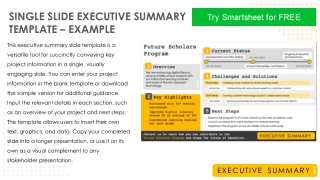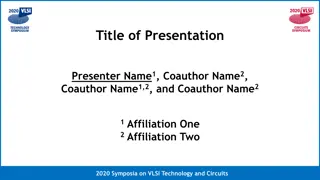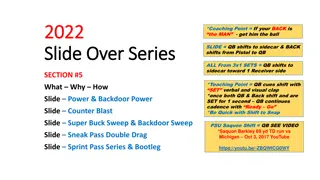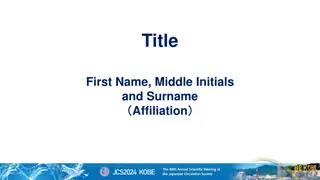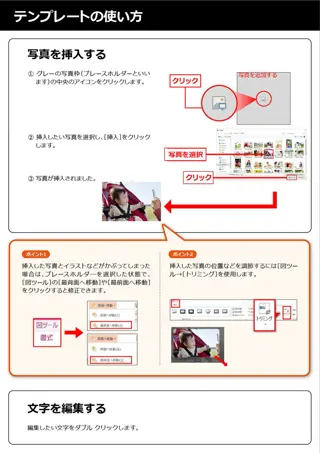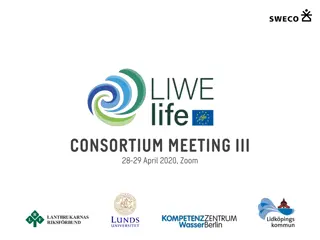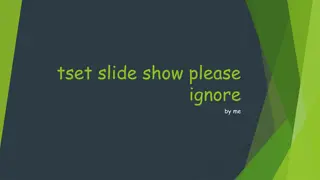
Effective Qualitative Data Analysis Approaches and Techniques
Explore the process of qualitative data analysis, including deductive and inductive approaches, key points in data analysis, handling survey results, and writing effective conclusions. Learn about organizing data, identifying frameworks, grouping data, and conducting second-order analysis for a comprehensive understanding of qualitative research.
Download Presentation

Please find below an Image/Link to download the presentation.
The content on the website is provided AS IS for your information and personal use only. It may not be sold, licensed, or shared on other websites without obtaining consent from the author. If you encounter any issues during the download, it is possible that the publisher has removed the file from their server.
You are allowed to download the files provided on this website for personal or commercial use, subject to the condition that they are used lawfully. All files are the property of their respective owners.
The content on the website is provided AS IS for your information and personal use only. It may not be sold, licensed, or shared on other websites without obtaining consent from the author.
E N D
Presentation Transcript
Design Methodology Desi Dwi Kristanto, M.Ds. Week 9
Approaches in analysis Deductive approach Menggunakan rumusan masalah untuk mengelompokkan data kemudian cari kesamaan dan perbedaannya Teori umum data & fakta Contoh Semua mahasiswa metodologi bersikap kritis Idham ialah mahasiswa metodologi Jadi, Idham bersikap kritis.
Approaches in analysis Inductive approach Dilakukan bila penelitian kualitatif menjadi cara utama pengumpulan data Data & fakta kesimpulan/teori Menggunakan framework yang muncul untuk mengelompokkan data dan mempelajari hubungannya Generalisasi Contoh Joni ialah mahasiswa metodologi Joni bersikap kritis. Jadi, semua mahasiswa metodologi bersikap kritis
Poin Penting dalam Menganalisis Data Teks Inti pesan/konten Sikap pembicara terhadap pesan/konten Pesan adalah pendapat pribadi atau pikiran bersama/kelompok Kondisi terkini atau pengalaman pembicara
Analisis dan Menangani Data Hasil Survei Validasi data Pengelompokan hasil survei coding standard analysis ordinal and nominal data analysis Ordinal misal: skala 1-5
Menulis Kesimpulan yg Efektif Fokus pada tujuan survei Buat Sintesis bukan ringkasan Tata Bahasa akademik + EYD Obyektif
The Process of Qualitative data analysis
The Process of Qualitative data analysis 1.Organisasi data 2.Identifikasi framework 3.Kelompokkan data sesuai framework 4.Gunakan framework untuk analisis deskriptif 5.Second order analysis
1 Organisasi data Buat transkrip Terjemahkan data Data cleaning, Pilih yang terpakai, sisanya kesampingkan atau disimpan Labeling Structuring Familiarizing
2 Identifikasi framework Baca data Identify a Framework Explanatory berdasarkan rumusan masalah Exploratory berdasarkan data Framework digunakan untuk membuat kerangka pengelompokan data Framework = Coding plan
3 Kelompokkan data sesuai framework Pengkodean data Modifikasi Framework Gunakan tools untuk entri data (komputer, relaman dll)
4 Gunakan framework untuk analisis deskriptif Descriptive analysis Range of responses in categories Identify recurrent themes *Stop here if exploratory research
5 Analisis Tahap Lanjut Pahami konteks data Kenali pola dalam data Kenali jenis responden Search for causality Identify related themes Bangun tahapan kejadian Cari data untuk menjawab rumusan masalah Bangun hipotesis dan uji hipotesis tersebut
Types of qualitative analysis Content analysis Narrative analysis Discourse analysis Framework analysis Grounded theory
Content analysis Content analysis is the procedure for the categorization of verbal or behavioural data for the purpose of classification, summarization and tabulation The content can be analyzed on two levels Descriptive: What is the data? Interpretative: what was meant by the data?
Narrative analysis Narratives are transcribed experiences Every interview/observation has narrative aspect-the researcher has to sort-out and reflect up on them, enhance them, and present them in a revised shape to the reader The core activity in narrative analysis is to reformulate stories presented by people in different contexts and based on their different experiences
Discourse analysis A method of analyzing a naturally occurring talk (spoken interaction) and all types of written texts Focus on ordinary people method of producing and making sense of everyday social life: How language is used in everyday situations? Sometimes people express themselves in a simple and straightforward way Sometimes people express themselves vaguely and indirectly Analyst must refer to the context when interpreting the message as the same phenomenon can be described in a number of different ways depending on context
Framework Analysis Familiarization: Transcribing & reading the data Identifying a thematic framework: Initial coding framework which is developed both from a priori issues and from emergent issues Coding: Using numerical or textual codes to identify specific piece of data which correspond to different themes Charting: Charts created using headings from thematic framework (can be thematic or by case) Mapping and interpretation: Searching for patterns, associations, concepts and explanations in the data
Grounded Theory Analytic induction Starts with an examination of a single case from a pre-defined population in order to formulate a general statement about a population, a concept or a hypothesis Then the analyst examines another case to see whether it fits the statement If it does, a further case is selected If it doesn t fit there are two options Either the statement is changed to fit both cases or the definition of the population is changed in such a way that the case is no longer a member of the newly defined population
Grounded Theory Metodologi penelitian kualitatif yang menekankan penemuan teori dari data observasi empirik di lapangan dengan metoda induktif (menemukan teori dari sejumlah data), generatif yaitu penemuan atau konstruksi teori menggunakan data sebagai evidensi, konstruktif menemukan konstruksi teori atau kategori lewat analisis dan proses mengabstraksi, subyektif yaitu merekonstruksi penafsiran dan pemaknaan hasil penelitian berdasarkan konseptualisasi masyarakat yang dijadikan subyek studi
Grounded Theory Then another case is selected and the process continues In such a way one should be able to arrive at a statement that fits all cases of a population-as-defined This method is only for limited set of analytic problems: those that can be solved with some general overall statement
Strategies for analyzing observations Chronology: describe what was observed chronologically overtime, to tell the story from the beginning to the end Key events: describing critical incidents or major events, not necessarily in order of occurrence but in order of importance Various settings: describe various places, sites, settings, or locations in which events/behaviours of interest happen People: describing individuals or groups involved in the events Process: describing important processes (e.g. Control, recruitment, decision-making, socialization, communication) Issues: Illuminating key issues how did participants change
Quality in Qualitative studies Criteria Credibility (internal validity) Issues Truth value Solution Prolonged & persistent observation, Triangulation, peer- debriefing, member checks, deviant case analysis Transferability (external validity) Applicability Thick description, referential adequacy, prevention of premature closure of the data, Reflexive journal Dependability (reliability) Conformability (objectivity) Consistency Dependability audit Reflexive journal Conformability audit Reflexive journal Neutrality


